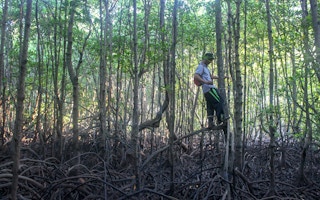Much of the mangroves, seagrass beds and coral reefs in Indonesia lie outside protected areas, which could thwart efforts at effective marine conservation, a new report shows.
Indonesia currently has 284,000 square kilometres (110,000 square miles) of marine area under protection. But 84 per cent of the country’s 2.79 million hectares (6.89 million acres) of mangroves; 55 per cent of its 295,000 hectares (729,000 acres) of seagrass meadows; and 57 per cent of its 2.52 million hectares (6.23 million acres) of coral reefs fall outside these MPAs. That’s according to the World Resources Institute’s Indonesian office (WRI Indonesia). In fact, less than 20 per cent of Indonesia’s MPAs cover these important marine ecosystems.
“These essential ecosystems, i.e. mangrove, seagrass, coral reef — the power of three, are known as ecosystems that function as habitat and protection for sea organisms, fish, including for nursery ground/reproduction,” Tezza Napitupulu, a former economics researcher at WRI Indonesia and lead author of the report published earlier this month, told Mongabay in an email.
With the threat of the climate crisis, there’s been a growing appreciate of these ecosystems’ importance as barriers against ocean disasters and as stores of carbon dioxide, especially mangroves and seagrass, said Napitupulu, who is now a lecturer at the University of Indonesia’s School of Economics and Business.
Indonesia plans to expand its MPA coverage to 325,000 km2 (125,000 mi2) by the end of this decade, or 10 per cent of its total territorial waters. From 2030 to 2045, the government plans to triple the marine protected area coverage to 975,000 km2 (376,000 mi2). The move is part of the country’s contribution to the global “30 by 30” conservation goal, which aims to protect 30 per cent of the world’s seas and lands by 2030.
“
Putting conservation effort in the centre of fisheries policy, or an ecosystem approach to fisheries management, is important.
Tezza Napitupulu, economics researcher, WRI Indonesia
“We’re calling for more of these essential ecosystems to be included in the marine protected areas in the future,” said Arief Wijaya, WRI Indonesia’s program director and a co-author of the report.
Still, Napitupulu noted that declaring an “MPA is not always the end game,” as studies have shown that state protection isn’t always effective, especially in areas where communities and other stakeholders are already managing the area and resources.
“For us, putting conservation effort in the centre of fisheries policy, or an ecosystem approach to fisheries management, is important,” she wrote in her email. “For example, creating networks of MPAs with other effective area-based conservation measures that might be managed by local or indigenous villages or communities, or local fisheries groups.”
The WRI Indonesia report also reviews other trends in marine resources and fisheries management in the country, such as marine-capture fisheries, aquaculture, and relevant national political developments.
Indonesia’s marine biodiversity plays an important role in the domestic and global supply of seafood. The country is home to some of the most diverse marine life on the planet, especially in its eastern region that falls within the Pacific Coral Triangle, an area renowned for its richness of corals and reef fish.
Marine zoning in Indonesia over the past 300 years has been designed systematically to support large-scale infrastructure development and other profit-oriented activities at the cost of the ocean ecosystem. A study shows that marine protected areas must safeguard natural resources, provide long-term benefits to local people, and have a zoning system, monitoring, surveillance, adequate staff capacity, facilities, and self-financing to be effective.
Indonesia has the largest expanse of mangrove forest of any country in the world, yet has lost 40 per cent of its mangroves in the past three decades. People cut the trees for timber and to make charcoal, and clear the forests to make way for fish and shrimp farms, according to the Center on International Forestry Research (CIFOR). The Indonesian government plans to rehabilitate 630,000 hectares (1.56 million acres) of mangroves by 2024.
The country is also home to an eighth of the total global expanse of coral reefs, made up of more than 65 per cent of known coral species. But it’s experienced several widespread coral bleaching events in the past four decades, which in some areas has caused the depletion of hard corals.
Indonesia’s coral reefs are also affected by inland activities such as deforestation and land-use changes, which result in silt washing out into reefs and killing corals. Government-led efforts to rehabilitate coral reefs have intensified since 2020 in the three provinces of Bali, East Nusa Tenggara and West Papua.
Indonesia is also widely considered an important country for seagrass conservation, but this ecosystem too has been in decline across much of the country’s waters.
“However good we try to restore, the resilience and effectiveness of the ecosystem is compromised when restoring,” Napitupulu said in her email. “Therefore, conserving ecosystems is valuable.”
This story was published with permission from Mongabay.com.










